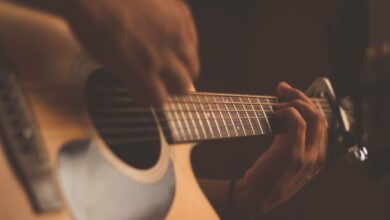Exploring the Role of Music in Different Cultures

Have you ever wondered how music can transcend language barriers and touch our souls? It’s fascinating to discover how music influences and shapes diverse cultures around the world. Let’s embark on a journey to explore the intriguing role of music in different cultures, unveiling the universal language that connects us all.
Music serves as an integral part of cultural identity, reflecting the traditions, beliefs, and values of a society. In many indigenous cultures, music is deeply rooted in rituals and ceremonies, acting as a bridge between the earthly and spiritual realms. The rhythmic beats and melodic chants create an enchanting atmosphere, allowing individuals to connect with their ancestors and invoke emotions that words alone cannot convey.
Beyond its ceremonial significance, music also plays a vital role in storytelling and preserving oral traditions. Through songs and ballads, cultures pass down their history from one generation to another, ensuring that their heritage remains alive. These musical narratives encapsulate the struggles, triumphs, and experiences of a people, acting as a time capsule that transports us to different eras and contexts.

Moreover, music acts as a powerful social glue, fostering a sense of community and unity within a culture. Whether it’s the lively samba rhythms in Brazil or the soul-stirring qawwali melodies in Pakistan, music brings people together, dissolving barriers and creating shared experiences. It provides a platform for individuals to express their emotions, celebrate joyous occasions, mourn losses, and voice societal concerns, channeling collective sentiments into harmonious melodies.
In addition to its cultural significance, music has a profound impact on our emotional well-being. Scientific studies have shown that music can influence our mood, reduce stress, and even alleviate pain. Each culture’s unique musical style evokes distinct emotions, captivating listeners and eliciting visceral responses. Just like a painting or a poem, music paints a vivid picture in our minds, evoking memories and transporting us to different emotional states.
Music is a universal language that transcends cultural boundaries, weaving together the tapestry of human experience. It is both a reflection of a culture’s identity and a means for individuals to connect with their roots. As we explore the diverse melodies and rhythms across different cultures, we gain a deeper appreciation for the power of music in shaping our world and touching our souls.
Harmony Across Borders: How Music Bridges Cultural Divides
Introduction:
Have you ever experienced the power of music to transcend language barriers and bring people from different cultures together? It’s truly awe-inspiring how melodies, rhythms, and harmonies can create a common ground that unites us all. In this article, we’ll explore the remarkable ability of music to bridge cultural divides, fostering understanding, appreciation, and harmony among diverse communities.
The Universal Language of Music:
Music is often referred to as the universal language because it communicates emotions and experiences in ways that words alone cannot. Regardless of our cultural background or mother tongue, we can connect with the melodies and rhythms that resonate deep within us. From classical symphonies to tribal chants, every culture has its unique musical traditions that reflect their identity and heritage.
Cultural Exchange Through Music:
When musicians from different cultures come together, they create a musical fusion that celebrates diversity. Collaborations between artists hailing from different parts of the world infuse their respective styles, instruments, and techniques, resulting in a beautiful tapestry of sound. These collaborations not only blend genres but also foster cultural exchange, enabling artists to learn from one another and showcase their heritage to a broader audience.
Building Bridges and Breaking Stereotypes:
Music has an incredible power to challenge stereotypes and break down prejudices. By exposing ourselves to music from unfamiliar cultures, we gain insight into their values, struggles, and aspirations, cultivating empathy and understanding. Through the melodies and lyrics, we can explore different perspectives, broaden our horizons, and develop a more inclusive worldview.
Music as a Tool for Social Change:
Throughout history, music has played a pivotal role in social movements and advocating for change. From Bob Dylan’s protest songs during the civil rights era to contemporary musicians using their platforms to address pressing global issues, music has been a catalyst for inspiring action and promoting unity. Songs have the ability to ignite passion, mobilize communities, and amplify voices that often go unheard.
Conclusion:
In a world divided by cultural differences, music stands as a unifying force that brings people together. Its ability to evoke emotions, foster cultural exchange, challenge stereotypes, and drive social change is truly remarkable. So whether you’re attending a multicultural music festival or simply enjoying the melodies of artists from around the world, remember the power of music in bridging cultural divides and embracing the beauty of diversity.
Unlocking the Rhythms of the World: A Global Journey into Cultural Music Traditions
When it comes to exploring the diverse tapestry of human culture, there is no better gateway than music. It transcends borders and languages, weaving together the melodies and rhythms that echo the essence of different societies. Join us on a captivating journey as we unlock the rhythms of the world, embarking on an awe-inspiring exploration of cultural music traditions from every corner of the globe.
Imagine standing amidst the vibrant streets of New Orleans, where the soulful sounds of jazz fill the air. The hypnotic beats of the trumpet, saxophone, and piano blend together, carrying you away on a tide of rhythmic expressions. Jazz, born out of African-American communities, has become a beacon of freedom and creativity, inspiring musicians worldwide.
Travel eastward to India, where the enchanting notes of the sitar transport you to a realm of spiritual awakening. This ancient instrument, with its intricate strings and resonating sound, echoes the depths of Indian classical music. Here, melodies are not merely melodies but a path to self-discovery, evoking emotions beyond words.
Venturing further, let’s delve into the heart of Africa, where the primal drumbeats resonate with the very pulse of life. From the Djembe in West Africa to the Talking Drums of Nigeria, each rhythm tells stories of ancestral wisdom and communal celebration. The energetic polyrhythms awaken the senses, uniting people in joyous dance and celebration.
Heading south to Latin America, we encounter the passionate rhythms of salsa and samba. With their infectious beats and lively melodies, these genres ignite the spirit and invite us to sway to their irresistible tunes. From the sultry ballrooms of Buenos Aires to the lively streets of Rio de Janeiro, Latin American music encapsulates the vivacity and zest for life that defines this region.
In the far east, the haunting melodies of traditional Chinese music transport us to a world of ancient tales and profound philosophies. The soft plucking of the guzheng and the wistful tones of the erhu create an ethereal atmosphere that captures the essence of Chinese culture. Each note is like a brushstroke on a canvas, painting vivid landscapes in our minds.
As we traverse the globe, one thing becomes abundantly clear: cultural music traditions are not merely notes and rhythms but living embodiments of a society’s history, beliefs, and aspirations. They unlock the door to a world of emotions and experiences, allowing us to connect with people from diverse backgrounds on a profoundly human level.
So let us embark on this global journey, where the harmonies of the world become our travel companions. Immerse yourself in the richness of cultural music traditions, and discover the universal language that unites us all – the language of music.
From Drum Circles to Opera Houses: Diverse Musical Expressions Unveiled
Have you ever stopped to marvel at the incredible diversity of musical expressions that exist in our world? It’s truly awe-inspiring how different cultures and communities have developed their own unique ways of creating and experiencing music. From the primal beats of drum circles to the grandeur of opera houses, let’s delve into the captivating world of diverse musical expressions.

Drum circles, often associated with tribal and indigenous communities, offer a raw form of musical expression that dates back centuries. These gatherings bring people together, uniting them through the rhythmic pulse of drums. As participants play their instruments, an enchanting synergy emerges, creating a mesmerizing experience that transcends language barriers. The immersive power of drum circles lies in their ability to evoke intense emotions and foster a sense of unity among participants.
On the other end of the spectrum, we find the magnificent opera houses that showcase the pinnacle of musical sophistication and theatricality. With their ornate architecture and opulent interiors, these venues provide a grand stage for performers to weave stories through music and song. The operatic tradition, born in Italy during the Renaissance, has spanned centuries and continues to enthrall audiences worldwide. From soaring sopranos to powerful basses, opera showcases the human voice in all its glory, accompanied by elaborate sets, costumes, and orchestras.
But what makes these diverse musical expressions so impactful? It’s their ability to connect with us on a profound level, transcending cultural boundaries and stirring our souls. They allow us to experience a range of emotions—joy, sorrow, excitement, or contemplation—that words alone cannot capture. Music becomes the universal language that speaks directly to our hearts, evoking memories, and awakening dormant emotions within us.

In a way, the world of music is like a vast tapestry, woven with threads of various colors and textures. Each musical expression adds a unique hue to this tapestry, contributing to its richness and depth. Whether it’s the primal beats of drums or the soaring melodies of opera, each form has its special place in our collective human experience.
So next time you find yourself tapping your feet to a catchy rhythm or getting lost in a powerful aria, take a moment to appreciate the incredible diversity of musical expressions that surround us. From drum circles to opera houses, they unveil a world of enchantment and emotion, inviting us to embark on a profound journey through sound and passion.
Melodies that Resonate: The Transformative Power of Music in Cultural Preservation
Have you ever experienced the magical power of music? It has the ability to transport us to different realms, evoking emotions and memories like nothing else. But did you know that music also plays a vital role in cultural preservation? Indeed, melodies have the incredible capacity to preserve and transmit the essence of cultures across generations.
Music serves as a time machine, allowing us to travel back and immerse ourselves in the traditions and stories of our ancestors. Through ancestral songs, dances, and rhythms, we can connect with the roots of our heritage and gain a deeper understanding of our shared history. These melodies serve as a bridge between past and present, weaving together the fabric of our cultural identity.
Think about it – when you listen to a traditional folk song or instrument, you are not just hearing a melody; you are hearing the echoes of an entire community’s struggles, triumphs, and values. Every note carries the weight of countless stories passed down through generations. This oral tradition is a living testament to the resilience and creativity of human beings.

In many indigenous communities around the world, music is an integral part of their daily lives. It accompanies rituals, ceremonies, and celebrations, reflecting their spiritual beliefs and honoring their ancestors. Through these musical expressions, cultural customs and values are preserved, ensuring that future generations do not lose touch with their heritage.

Moreover, music transcends language barriers, making it a universal language that communicates directly to our hearts and souls. It has the power to foster empathy, build bridges between diverse cultures, and cultivate respect for one another. In today’s interconnected world, where globalization threatens to erode unique cultural identities, music acts as a powerful force of resistance, reminding us of the beauty and importance of cultural diversity.




